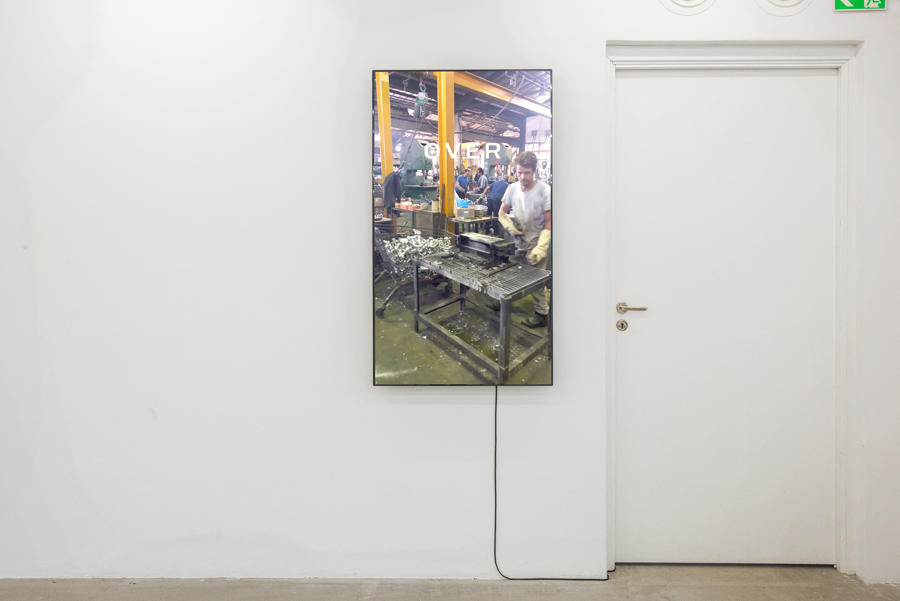Sidsel Meineche Hansen: Getting Over Uber
At Stockholm’s Index, riffing on the dangers of Fascism, bad corporations and big tech
At Stockholm’s Index, riffing on the dangers of Fascism, bad corporations and big tech

Fifty years on from the uprisings of May 1968, Sidsel Meineche Hansen has deftly branded their exhibition, ‘OVER’, with an icon that would make the situationists gleam. The artist has hijacked the logo of the car service Uber, superimposing it with a swastika and a red strike-through band to denote a negation. On both a linguistic and visual level, this move slides signifiers. Über, which translates to ‘above’, is inexorably linked to the Nazi’s use of the term to imply German racial supremacy: ‘Deutschland über alles’ (Germany, above all else), while today ‘uberization’ has become a term of art signifying disruptive innovations within the service industry. And yet, several years on from these cyber-economic revolutions, the tech industry – and notably Uber – is facing increasing flak for simply replacing one set of robber barons with another, replete with accelerated forms of disenfranchisement not limited to economy. Hansen, likewise, puns ‘above’ with its near-synonym ‘over’ as a call to arms to end such structures before they become endemic to daily life. The artist turns these means against themselves by presenting viewers with an app to tour the exhibition.

Visitors are confronted with a series of cast metal discs with eyeholes, which evoke neutral-face emojis and are hung in a single horizontal line on a white wall. These masks can be animated through a purpose-built smartphone app, allowing audience members access to an augmented reality that, for all intents and purposes, portrays the often hidden but very tangible effects of automation systems. Aping facial recognition software, the app grafts motion capture points onto each visage as a series of red highlighted crosses. These highlights interlace to form various facial expressions that generally emote signs of discomfort, while headphones allow the masks to speak of the varied forms of exploitation perpetrated by these systems and their predominantly white male owners. Setting the stage, the app begins with an infamous viral video wherein former Uber CEO Travis Kalanick berates a POC Uber driver, who protests that, in forcing its drivers to foot the operating costs of their vehicles, the company misleads its drivers with false profit claims and traps them in a state of indentured penury.
The video could not have come at a worse time for Uber. The company was already undertaking extensive damage control following the 2017 travel-ban protests, during which activists raced to airports such as New York’s JFK in order to safeguard migrants, and Uber, in a craven act of opportunism, raised its fare prices. With these events in mind, Hansen’s allusion to Nazi history casts Uber in a similar light as such companies as Krupp, IG Farben and other industrial collaborators of the Third Reich.

History doesn’t repeat itself, but it often rhymes. Krupp, which produced armaments during World War II, and IG Farben, which made the gases used in death camps, thrive on as some of the world’s most powerful multinational corporations, the latter in the form of its various subsidiaries. Although Kalanick was ultimately removed as Uber’s CEO (in the wake of a gross sexual harassment scandal), he still retains his shares of the ever-expanding multibillion dollar empire. The show’s title is thus harrowing, as it would appear that bad actors can still get one ‘over’ on us. That is, unless continued forms of vigilance, protest and action – in the exhibition, a reader recounts the travel-ban protests, the blog of Uber whistle-blower Susan Fowler and the story of how activists in east London shuttered LD50, a gallery that provided a platform for alt-right art and its theories – make sure that the inclusionary mandate of democratization is never over.
Sidsel Meineche Hansen: OVER runs at Index - The Swedish Contemporary Art Foundation, Stockholm until 10 June.
Main image: Sidsel Meineche Hansen, Hollow Eyed, 2017, Investment cast in silicon metal by London Bronze Casting Ltd and Maybrey Foundry, London. Courtesy: the artist and Index - The Swedish Contemporary Art Foundation, Stockholm; photograph: Johan Wahlgren






















